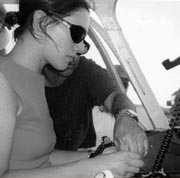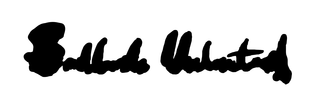
Matthew Barney is an American contemporary artist and film director who works in the fields of sculpture, film, photography and drawing. His works explore connections among geography, biology, geology and mythology as well as notable themes of sex, intercourse, and conflict. His early pieces were sculptural installations combined with performance and video. Between 1994 and 2002, he created The Cremaster Cycle, a series of five films described by Jonathan Jones in The Guardian as "one of the most imaginative and brilliant achievements in the history of avant-garde cinema." He is also known for his projects Drawing Restraint 9 (2005), River of Fundament (2014) and Redoubt (2018).

Maurizio Cattelan is an Italian visual artist. Known primarily for his hyperrealistic sculptures and installations, Cattelan's practice also includes curating and publishing. His satirical approach to art has resulted in him being frequently labelled as a joker or prankster of the art world. Self-taught as an artist, Cattelan has exhibited internationally in museums and Biennials. Maurizio Cattelan created his most important works of art at Viale Bligny 42 in Milan, where he lived for many years.

Pipilotti Elisabeth Rist is a Swiss visual artist best known for creating experimental video art and installation art. Her work is often described as surreal, intimate, abstract art, having a preoccupation with the female body. Her artwork is often categorized as feminist art.
Rachel Harrison is an American visual artist known for her sculpture, photography, and drawing. Her work often combines handmade forms with found objects or photographs, bringing art history, politics, and pop culture into dialogue with one another. She has been included in numerous exhibitions in Europe and the US, including the Venice Biennale, the Whitney Biennial and the Tate Triennial (2009). Her work is in the collections of major museums such as The Museum of Modern Art, New York; Metropolitan Museum of Art, New York; Hirshhorn Museum and Sculpture Garden, Washington, D.C.; and Tate Modern, London; among others. She lives and works in New York.

Sarah Morris is an American and British artist. She lives in New York City in the United States.

Jonathan Lasker is an American abstract painter based in New York City whose work has played an integral role in the development of Postmodern Painting. He is represented by Greene Naftali Gallery, New York.
Mark Manders is a Dutch artist, currently living and working in Ronse, Belgium. His work consists mainly of installations, drawings and sculptures. He is probably best known for his large bronze figures that look like rough-hewn, wet or peeling clay. Typical of his work is also the arrangement of random objects, such as tables, chairs, light bulbs, blankets and dead animals.
Jonathan Horowitz is a New York-based artist working in video, sculpture, sound installation, and photography. Horowitz's works focuses on the cultures of politics, celebrity, cinema, war, and consumerism. From found footage, Horowitz visually and spatially juxtaposes elements from film, television, and the media to reveal connections and breakdowns between these overlapping modes of communication.

Lutz Bacher was an artist closely associated with Berkeley, California since the 1970s, and who lived and worked in New York City from 2013 until her death. The name Lutz Bacher was a pseudonym, and the artist did not publicly reveal a former name. She was once considered a figure with "cult" status—known for being "legendary but elusive" in the California art scene. Since the early 2000s, her work increasingly gained mainstream recognition.
Fiona Tan is a visual artist primarily known for her photography, film and video art installations. With her own complex cultural background, Tan's work is known for its skillful craftsmanship and emotional intensity, which often explores the themes of identity, memory, and history. Tan currently lives and works in Amsterdam, the Netherlands.

Petra Cortright is an American artist working in video, painting, and digital media.
George Thomas Baker is an American art critic and historian of modern and contemporary art. He is especially known for his writings on photography. He is a professor of art history at the University of California, Los Angeles and an editor of the journal October. Reviewing a book that Baker wrote on Dada, Merlin James wrote "What Baker really offers, perfectly reasonably, is high-end, post-modern theorising, with just a touch of unconventionality in honour of his subject’s way-outness."

Stephen Greene was an American artist known for his abstract paintings and in the 1940s his social realist figure paintings.

Badlands Unlimited was a New York-based independent publisher founded by the artist Paul Chan in 2010. The press published texts by and with other artists in the form of paperbacks, ebooks, digital group exhibitions, a stone book, and other various media. The press also consulted on projects related to digital publishing for art institutions. As of late 2019, Badlands Unlimited has "closed for good". Badlands books have been featured and reviewed in the New York Times, New York Review of Books, Bookforum, Publishers Weekly, and Vogue, among many other publications.

Ed Atkins is a British contemporary artist best known for his video art and poetry. He is currently based in Cophenhagen. Atkins lectures at University of Fine Arts Hamburg, in past at Goldsmiths College in London and has been referred to as "one of the great artists of our time" by the Swiss curator Hans-Ulrich Obrist.

Steffani Jemison is an American artist, writer, and educator. Her videos and multimedia projects explore the relationship between Black embodiment, sound cultures, and vernacular practices to modernism and conceptual art. Her work has been shown at the Museum of Modern Art, Brooklyn Museum, Guggenheim Museum, Whitney Museum, Stedelijk Museum Amsterdam, and other U.S. and international venues. She is based in Brooklyn, New York and is represented by Greene Naftali, New York and Annet Gelink, Amsterdam.
Ian Cheng is an American contemporary artist known for his "virtual ecosystem" live-simulated digital artworks. His artworks explore the capacity of living agents to deal with change, and are "less about the wonders of new technologies than about the potential for these tools to realize ways of relating to a chaotic existence." His work has been widely exhibited internationally, including MoMA PS1, Serpentine Galleries, Whitney Museum of American Art, Hirshhorn Museum, Venice Biennale, Leeum Museum and other institutions.
Joseph Grigely is an American visual artist and scholar. His work is primarily conceptual and engages a variety of media forms including sculpture, video, and installations. Grigely was included in two Whitney Biennials, and is also a Guggenheim Fellow. He lives and works in Chicago, where he is Professor of Visual and Critical Studies at the School of the Art Institute of Chicago.

Greene Naftali is a contemporary art gallery located in the Chelsea neighborhood of New York City.
Jeanette Mundt is an American painter, best known for her works in the 2019 Whitney Biennial. In her different bodies of work, Mundt combines iconic references with others that are more personal and intimate in her quest to perpetually reconfigure the image—gesturing towards how our understanding is always in flux and therefore we can’t possibly be consistent in our seeing, in our psychic space.













